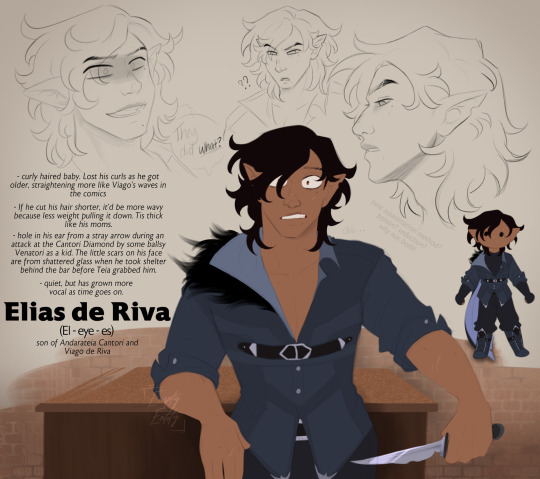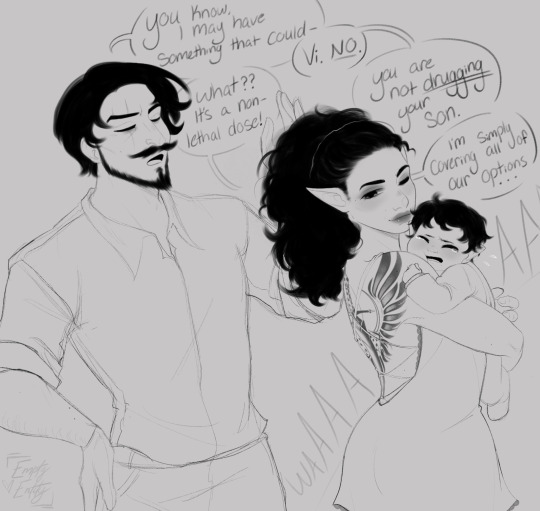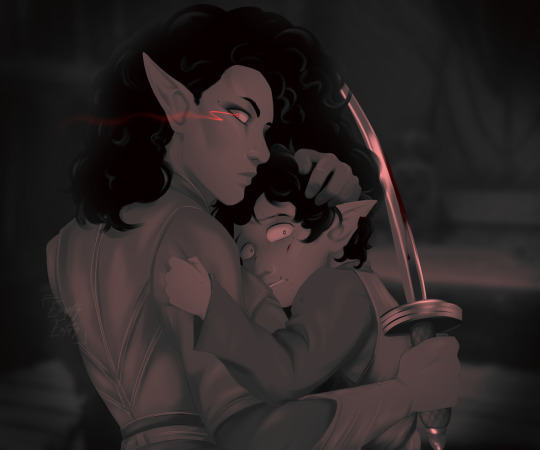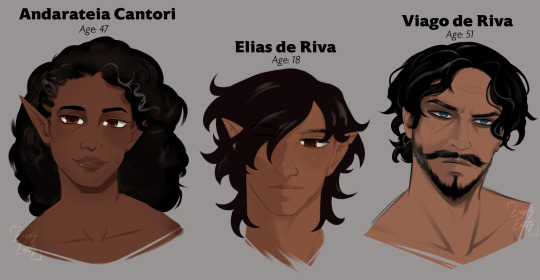#^i have a weird aversion to like just doing flashbacks straight up but i’ve realized that’s how you have to write thing’s coherently
Explore tagged Tumblr posts
Text
trying to be smart and different with your stories is a disease and i have it
#i’m trying to think of some stuff in ph a little more normally and it’s making more sense#like obviously#but trying to be ahead of an audience that doesn’t exist or is just your friends is so fucking silly#^i have a weird aversion to like just doing flashbacks straight up but i’ve realized that’s how you have to write thing’s coherently#lord
0 notes
Text
When two NPCs with maybe 5 total minutes of screentime have you so obsessed you give them a child 🏃🏻

BEHOLD—my Teiago fankid, Elias de Riva (plus an info dump about him and his parents below because I’m very normal abt them but you can skip that and jus look at all the art if you want 🫣)
Realistically, it’s really hard to imagine a scenario where these two have a kid. But that’s what fanart and hcs are for 🙌 As of right now, I hc that around the time of the dialog from one of the crows abt Teia and Viago being "on again" is when he's conceived. But they don't really find out until after the ending of Veilguard. Any symptoms Teia might experience beforehand are just written off as stress or straight up ignored because of how much they have on their respective plates with the Antaam and the gods. Viago even calls her out for never going home and insists she takes a contract to “kill a vacation.” So I don't think it'd be too far fetched for her to look the other way until things are settled in Treviso again because of timeline stuff.
No clue how they react after the initial news rn but that can come later. They start being a little less childish with their back and forth break-ups at least once the seriousness of it all sinks in lol

Viago did not like the idea at first, I know that much. Mans was STRUGGLING with Elias in the early stages. Babies are loud, unpredictable, often inconsolable little heathens that he can't analyze or have a consistent system for. It would drive him nuts. A tiny human who can't yet care for itself and constantly needs to be held and directed, paired with his touch-aversion, OCD, and need for set routines? Yeahhh…Teia understands, but on one hand that woman just went through 9 months of her own hell and she's shoving that boy into his arms sometimes regardless of his bad days LMAO
It helps, in the end. Pushes him to gradually get used to it over time. Viago starts to realize there is somewhat of a system to the whole dad thing and fatherhood grows on him because I said so.
He holds a lot of resentment and hatred towards his own father. As a bastard of the king and one of his drunk mistresses, I doubt Viago’s upbringing was too great. The whole “demon teeth” comment was enough to hint as such. He wouldn't be thrilled about taking care of a baby, but the thought of entrusting his son to nannies? Strangers?? No. That's something his dad would and did do and he’s better than him. This is his kid; He doesn't care if it's gross, he'd rather feel uncomfortable sometimes for the sake of Elias’s comfort than stoop as low as the king.
On top of spite, the paranoia with poison extends to Elias in a way; one of my favorite hcs I’ve seen is Viago being exposed to assassination attempts on the king or his mistresses/servants while he was growing up before joining the crows, whether it’s via stories or witnessing first hand. The thought of entrusting Elias’s life to anyone else gives him flashbacks to being a child himself, scared to eat or drink anything prepared by anyone because of how many times others were killed that way around him. Even doing extensive checks and handpicking a trustworthy nanny is not reliable and doesn’t guarantee safety. We love a paranoid dad.

Teia on the other hand? | think she'd like a family tbh. Maybe she didn’t react well to first finding out she was pregnant, but otherwise the idea grows on her quickly compared to Viago. As an orphan, she didn't get much of a family—the crows became her family, Caterina as her "nonna" and some of the older Talons as her weird uncles. Being able to experience what she never had with a child she can ensure has a good life feels fitting for her character. Heals a bit of her own inner child too, yk? 🫠 She’s such a caring woman despite her occupation and she’d make a good mother. Scary, but good LMSKSKX
Life as a crow is harsh. Being the child of not one but two Talons?? On one hand that kid is very protected but on the other he has a huge target on his back. If Viago was worried about people thinking House de Riva and House Cantori had an alliance, I can only imagine what a wholeass child would stir up. They both would prepare him well for the future in their own ways. It’s not canon to him, but the thought of Elias being ridiculously resistant to poisons because Viago started building his immunity up so young is funny to me 😭

Anyways ramble over. Some creative liberties were taken, such as his eyes being more golden like how Teia’s are described in Tevinter Nights. I may give Elias his curls back because he looks goofy next to Teia and Viago with his emo hair JAKAMC
I love their little family…
#dragon age#dragon age the veilguard#datv#teiago#teia x viago#viago de riva#andarateia cantori#canon x canon#fankid#oc#headcanon#the brainrot is real#Elias de Riva
37 notes
·
View notes
Text
Is This How I See Jaime?
Objectively speaking, I am not that old. Still there’s no getting past the fact that I am getting older every day, like everybody else. I might not be at the point where my body betrays my age, where I ache all the time and grunt when I stand, but my mind still carries with it the weight of decades of lived experience, and this can at any moment make me want to lie down.
There are few artists that capture the feeling of aging quite like Jaime Hernandez. Partly this is because of his working method. No one else does what he does, making serialized comics for close to forty years, that tell stories with the same characters. These are not truly STORIES, utilizing flashbacks that provide crucial context to events and create literary effects, even as the overall narrative they tell moves forward in time and builds an attachment between reader and character comparable to long-running television series. Still, when broken up into serialized installments in issues of Love And Rockets, it can frequently feel like nothing is happening. Often, what you get in an individual issue is around fifteen pages, split between multiple pieces focused on different characters. These fragments are focused, compressed in a manner closer to cinema than television, but you’re still only getting what might amount to three to five minutes depicted on-screen. With a few exceptions, what you get in an issue is not a complete short story with a beginning, middle, and end. For all the influence the Hernandez Brothers have had on alternative comics, reading the people they’ve influenced will not prepare you for how much Love And Rockets is modeled off of serialized comics, and how much of its power it draws from continuity and extended engagement.
This pacing demands a certain level of expectation-free interaction, which is crucial to deep relationships. It’s worth noting Jaime’s strips run alongside his brother Gilbert’s work, which is similar in some ways, but by no means the same. Gilbert’s body of work is a lot more complicated, due in part to how prolific he is, the meta/self-referential/self-deconstructive elements of the stories he’s telling, and also how he draws tits like Mark Newgarden draws noses, that just keep getting larger. He deserves a deep critical reading, but I don’t have the energy, money, or time to keep up with him. Running the two brothers’ work side by side makes Love And Rockets implicitly about family, which then in turn becomes a subject each cartoonist explicitly makes work about. And not just “chosen” family, but the actual people who’ve known you your entire life. Which is, inherently, a concept which both means more the older you get, and remains somewhat alienating. As a reader, it helps to be prepared to extend to Love And Rockets the goodwill one would a family member, to begin to get on its level.
On a superficial level, making work about family seems somewhat conservative and nostalgic. That’s not to suggest it’s not valuable, or worth fighting for. There’s just a certain adjustment of values or attitudes a reader needs to make to get on board with the work, that might be at odds with the punk rock alternative comics reputation that precedes it. The comics themselves are built on a formal language of cartooning that’s older and out of fashion: Sixties Ditko comics, Lil Archie, Dennis The Menace Goes To Mexico. This adds to a feeling of being about aging in a way younger art cartoonists inspired by their same-age immediate peers can’t get to. For instance, I love Olivier Schrauwen, and I can see the influence Yuichi Yokoyama has on his work, and I view the two of them as peers in dialogue, creating the future of comics, which creates a totally different reading experience than I get reading work that feels more in dialogue with the past. The formal choices of the Hernandez brothers, including that their work appears for the first time in serialized comic book formats, calls conscious attention to history. Consciousness of the past hurts, and this truth is a huge element of the plots and themes of Jaime’s work.
It’s the sheer graphic strength of Jaime’s drawing that enables it to stick in the memory. He’s able to capture a tiny gesture and render it iconic through use of line and spotted blacks. The precision he brings his images gives them a certain ease of recall. This is the crux of a two-page spread at the climax of The Love Bunglers where, as a bunch of different stories and images are recalled, now rendered at different angles, they’re all there in your consciousness, in a mix of your memories of the comic and your memories of your own individual life. It’s a hugely cathartic climax.
However, both Gilbert and Jaime have this aspect to what they do that can easily frustrate a reader, and it is seemingly inextricable from the core of their power: Once a point is reached where you can easily follow along, and a satisfying conclusion to a story occurs, the next several issues will completely destabilize that and you will again not know what exactly is going on. For instance, if you read the Perla La Loca collection, collecting the “Wigwam Bam” and “Chester Square” graphic novels, by the end of it, you will have a very exciting experience that should convince you Jaime Hernandez is one of the greatest cartoonists in the world. Reading the Penny Century collection of the work that followed, plenty of stories will leave you feeling like he lost his touch, or is spinning his wheels. At the end of the book, and the “Everybody Loves Me Baby” story, you’re knocked flat on your ass again, but if you had read the original comic books as they came out, who knows if you would’ve stuck it out that long.
This, by the way, is one of the most realistic things there is. Life’s “things just keep happening” quality will fuck you up time and again. While I haven’t given up on life just yet, I have stopped reading Love And Rockets a few times. I’m not the sort of reader who sticks with a series out of inertia. I have always been hyper-aware of the value of my comic-book buying dollar, and therefore pretty fickle. If I read two issues straight of a comic that feels like it’s treading water, I would be done with it. I’ve gone back and picked up things after the fact and filled in gaps, or I’ve switched to reading trade collections checked out from the library. I bought the first two issues of the recently relaunched Love And Rockets volume 4 in one go, realized that it was continuing stories from Love And Rockets: New Stories, and didn’t go back for more, put off by the stories’ continuation from the previous volume.
It’s only now, with the release of Is This How You See Me and Tonta, that I am reading the stories that followed up The Love Bunglers in a complete form. They blew me away. The effects Jaime’s going for at any given moment may be subtle, but they accumulate, and this accumulation then becomes the true effect, and why I analogize it to aging: There’s this sheer weight that results from how things just continue to happen, and each time they hit you with what feels like more force, even as the moments themselves are minor ones. This is a true-to-life feeling that is very hard to capture. It’s present in the relentless pace of Charlie Kaufman’s masterpiece Synecdoche, New York, but that is a movie too intense to rewatch for many. Jaime’s work is built around you returning to it, which means it has to be somewhat inviting, and include levity.
Is This How You See Me focuses on the characters of Maggie and Hopey, introduced in 1981 as teenagers, now presumably in their mid-fifties, happily married to other people but still weighing the possibility of cheating with their ex. The characters return to a “punk rock reunion” in their hometown, to reminisce on the past with old friends, and old characters we haven’t seen in years appear, visibly older than when they were last drawn, but still recognizably themselves. This plot lends the comic some elements of nostalgic fan-service that I intellectually feel an aversion to. It feels almost like the plot is designed transparently for those purposes. Bringing back old characters would strike me as a crass project in the pages of X-Men or Legion Of Super-Heroes, but the naturalism of Jaime’s approach means that it allows him to show me things I legitimately haven’t seen in a comic book before. It’s probable they’ve been in movies or books, but I would argue they work better in comics.
For instance, there’s a scene where the reunited cast are showing each other photos on their phones. This is a normal thing people do, and so surely it has been depicted in a film. But in a comic, there’s this weird meta element to it. Smartphones have text message conversations appear in little word balloons, right? The word balloon being a technique comics used to depict speech, as part of their normal communication system of images. Then, when interacting in physical space, people show pictures to each other, using this device they usually use for the mimesis of speech over distances, but they’re communicating using pictures to show what their life is like. Which is what the comic itself is doing more generally. So, there’s there’s this semiotic quality to the gesture of the outstretched hand with phone in it which feels really profound when depicted in comics, while it would feel sort of stupid and uncinematic in a movie, where the aging theater audience would have to squint and ask their neighbor what is being shown in the text message they’re seeing on screen.
Similarly, we see the married couple of Maggie and Ray, separated from each other for the length of the weekend, fretting over how much they should be in communication, drafting texts and deleting them. There’s an intimacy people who live with each other share, where much of what they encounter apart from the other person they want to talk to them about, because to be close to another person is to have them in some ways always present inside your head. Depicting the writing of a text, and then the decision to delete it, captures both the intimacy of a couple and the intimacy of one’s own private thoughts, in a way that only a form with the intimacy of a comic is able to depict effectively. Prose alone can’t capture the fluctuations of posture and self-presentation which is the heart of deleting a draft.
Concern for one’s image is depicted as well in the title pages to individual chapters, showing characters taking pictures of themselves in mirrors with their phones. These pages seem to depict not so much the cultivated selfie but the self-awareness of the drafting process, the titles above them taking on a certain poetry, built around the words spoken to oneself unconsciously that are the opposite of the language one chooses to send in a message to convey a precise thought.
This stuff really impressed me, and it all fits within a language of small gestures. While there are tons of books that are about how connection works in the digital age, it also always feels like that stuff is a commentary on how young people live. I’m not sure I’ve seen anything as interested in how people in middle age use these devices. Of course, it’s possible examples exist in work targeted to older audiences, and I just missed it because it wasn’t marketed to me.
It was actually Jaime’s other 2019 book, Tonta, that spoke to me more. Here, the aging the book is about is a coming-of-age thing about a high school student, and the book has this spirited youthful quality to it from the outset. While other, darker, plot elements unfold as it goes on, what was interesting to me is that the noir-like narrative that exists as a counterpoint in the finished book might not have even seemed part of the same story to a reader of Love And Rockets, where the character nicknamed Tonta just sort of suddenly emerged. There’s even a few pages in this collection given over to narration by Ray, who otherwise doesn’t appear in the book. These elements don’t seem dissonant or like they don’t belong. It just makes the book itself feel loose, like it feels as free and exploratory as a teenager looking for something to do. Placed together inside a book, the disparate threads become united by having a main character to pay attention to how developments of the plot affect her. The book has a real tonal arc as it unfolds, and the way the book gets you in its grip from such a goofy start seems to replicate how the stories about the Maggie character developed over time, here captured in miniature.
The sum of these two books will at some point only be a portion of a future volume of the Love And Rockets library, the formatting of the Perla La Loca and Penny Century books I mentioned earlier. There are portions from recent issues of Love And Rockets that are natural continuations and codas from these books, and what tapestries these fragments will be woven into is unknown to me. Another gutpunch could be just around the corner or years in the offing. There’s really no way to know what the future holds.
2 notes
·
View notes